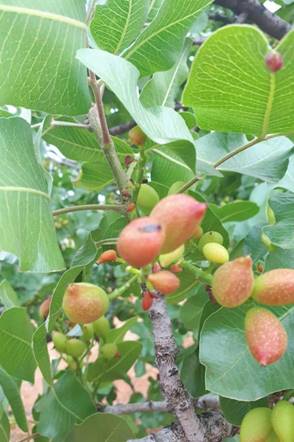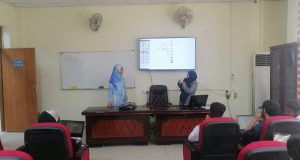Pistachio Tree Of the perennial fruitful trees, some of which can live for up to three hundred years, Withstands high temperatures and needs 500 mm of rain annually, usually cultivated for its fruitful, As the tree begins production at the age of 10 years lightly and at the age of 15 years well and reach its full growth and production mostly after forty years of age, Pistacia vera L belongs to the genus Pistacia L.
Pistachio trees are a desirable species, since their fruits are valuable legumes with high economic and nutritional value, and an important source of mineral nutrients, vitamins and salts and a necessary and important food for humans, as fruits are used as an alternative treatment for cancerous tumors in the liver, pain reliever, and blood aggregate, very useful in treating gynecological diseases, The Islamic scholar Ibn Sina stated that the fruits of pistachios are much hotter than nuts, as they open the livers of the liver and work to strengthen memory and cure diseases of chronic cough and help to remove oral ulcers, and Ibn Al-Bitar said that pistachios are a good fruit that purifies the liver and benefits from chest and lung ailments and strengthens the heart.
In general, every 100 grams of pistachio seeds contain approximately more than 550 calories, as they are very rich in proteins, fats and dietary fibers, as they contain 20% of sugar, 20% of proteins, and 50 – 60% of fats in relation to dry weight. it contains a high percentage of monounsaturated fatty acids, such as Oleic acid, Linoleic acid, and Linolineic, and contains Palmitic acid, which is rich in vitamins such as Vitamin A and Vitamin B1, B2 and B6, as well as its fruits are of high nutritional value as they contain many different nutrients especially calcium, potassium, iron, magnesium and phosphorous.
All United Nations reports indicate the importance of growing pistachio trees in the world from an economic point of view through statistical data issued by the World Food and Agriculture Organization (FAO), which clearly shows the increase in fruit production annually, after production at the end of the sixties of the last century was about 32 thousand tons And 100 thousand tons in the beginning of the eighties and a quarter of a million tons in the beginning of the nineties and a half million tons at the end of the twentieth century, and in 2018, the global production of pistachios was about 1.4 million tonnes, with Iran and the United States as leading producers, together accounting for 72% of the total . A 2020 report indicated that nearly half of the global production of pistachios in 2019 came from the United States, with production in Iran falling to as low as 7% due to US trade sanctions against Iran, climate change, and weak economic and water management in Iran.
The origin of the pistachio tree dates back to the Islamic Republic of Iran and is cultivated on large scales in warm or temperate climates and in sunny places, whether in clay, sandy, wet or dry soils, especially soils near grassroots or low acidity as they extend from Afghanistan to the Mediterranean and California According to the statistics of 2018, the Islamic Republic of Iran leads the world in the production of pistachios, with a total production of 551.307 tons, then followed by the United States of America, Turkey, China and the Syrian Arab Republic in the fifth rank, then Greece, Spain, Italy and Afghanistan and is cultivated abundantly in northern Iraq, especially the poor mountain areas and some areas within Mosul and Sinjar district.
Pistachios are infested with many insect pests. Kapnodis is one of the most dangerous enemies of these trees, as its larvae that live in the roots lead to the death of adult trees within a year or a little more.
Dr. Sabah Gazi Shareef Al-Agha
 University of Kerbala
University of Kerbala
































































